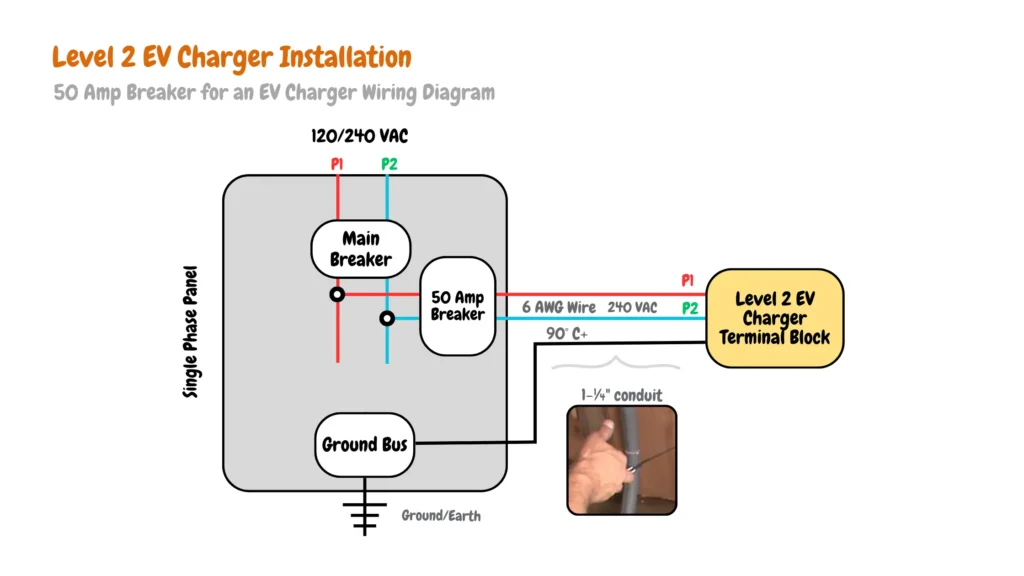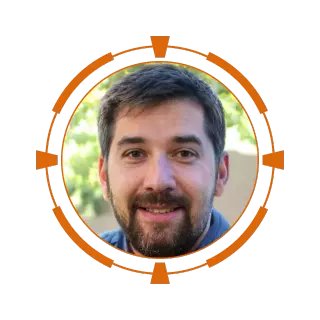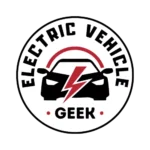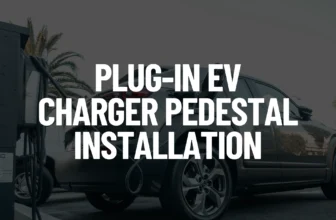If you’re seeking the best 50 amp breaker for an EV charger, you’re likely navigating between replacing a faulty Level 2 charger circuit breaker or installing a new one. Home Level 2 chargers commonly utilize 50-amp breakers, contrasting with the lower amperages needed for Level 1 EV chargers (20 amps and below) and the higher demands of Level 3 EV chargers (100 amps and above).
A 50-amp breaker safeguards your Level 2 EV charging circuits against overload, instantly disconnecting power in the event of an electrical fault, thus preventing potential electrical hazards like shocks or fires.

Replacing a 50-amp circuit breaker is typically straightforward, given its plug-and-play nature. However, selecting the right one can be challenging for some shoppers.
Whether you’re searching for the best overall, budget-friendly, outdoor features, double pole or renewable energy EV charging support, or other specific features in a 50-amp circuit breaker, our expertise in installing and replacing Level 2 EV chargers circuit breakers equips us to offer tailored recommendations based on first-hand experience, installation scenarios, and client feedback.
Here, we present our expert picks for 50-amp breakers suited for Home Level 2 EV charger installations.
- Best Overall For Home EV Charger: Square D 50A Single Pole Circuit Breaker
- Best Bang For The Buck: Siemens 50A Single Pole Circuit Breaker
- Best For Outdoor Installation: Square D 50A Molded CASE Circuit Breaker
- Best Double Pole: Siemen 50A Double Pole Circuit Breaker
- Best For Solar EV Charging System: Chtaixi 50A Single Pole Protector for PV Systems
Table of Contents
Best 50 Amp Breaker for an EV Charger
Our list of the best 50 amp breakers for an EV charger features a comprehensive range of the best amp breakers for a 50 amps Home Level 2 EV charger installation.
Best Bang For The Buck
Square D 50A Single Pole Circuit Breaker
The Square D 50A Single Pole Circuit Breaker is our number one pick because the manufacturer is reputable and reliable for high-quality, durable, and budget-friendly electronic components, and most electricians and homeowners are familiar with the brand and recommend them for use in residential electrical installations due to their reliability, availability, and compatibility with common electrical panels.
This means there is a higher chance your electrical panel already consists of Square D single pole breakers for other electronic devices making it easy to integrate, install, and use them without incompatibility issues with your EV panel or components of your EV charging set-up.
The Square D 50A Single Pole Circuit Breaker takes only one slot in the EV charging main electrical panel or EV charging subpanel leaving a lot of space for other EV charging components such as smart meters, wiring, sensors, etc.
Best Overall For Home EV Charger
Siemens 50A Single Pole Circuit Breaker
Siemens 50A Single Pole Circuit Breaker is also a common electronic component in many residential buildings, Siemens is known to manufacture service panels, circuit breakers, and various electrical components you are already familiar with in your home electrical installation.
The Siemens 50A Single Pole Circuit Breaker is a direct competitor of the Square D 50A Single Pole Circuit Breaker when it comes to 50-amp circuit breaker installations in EV charging electrical panels, the performance of the two-level 2 electrical circuits is similar including the same level of EV charging overcurrent protections, and EV charging load management.
However, the Square D 50A Single Pole Circuit Breaker is competitively priced, making it more budget-friendly than the Siemens 50A Single Pole Circuit Breaker, ultimately both circuit breakers are commonly used for Level 2 EV charger installations and they offer excellent functionality, the choice will probably be the cost, and load center compatibility depending on your EV charger electrical panel.
Best For Outdoor Installation
Square D 50A Molded CASE Circuit Breaker
If your level 2 EV charger service panel is outdoors, we highly recommend considering the Square D 50A Molded Case Circuit Breaker, they offer the same functionality as the Square D 50A Single Pole Circuit Breaker, however, they differ in design, features, and suitability for outdoor installation.
Molded Case Circuit Breakers (MCCBs) prove their worth in EV charger installations due to their robust, molded case construction. This design offers superior durability, withstanding the demands of smart EV chargers with long charging sessions and high currents typical of Level 2 EV charging. MCCBs also excel in environmental protection, resisting damage from moisture, dust, and temperature fluctuations, common concerns within electrical panels.
The Square D 50A MCCB emerges as a strong candidate for long charging sessions and high-current EV charging applications. It incorporates both thermal and magnetic protection mechanisms, safeguarding against sustained overloads and reacting swiftly to short-circuit events. This combined protection surpasses basic circuit breakers, offering a comprehensive solution for overcurrent protection in your EV charging system.
Best Double Pole
Siemen 50A Double Pole Circuit Breaker
Most single-family home EV charger installations in the United States are connected with single-pole electrical systems, however, there are some residential homes with double-pole electrical panels that require a 240V supply to power the big breaker box that requires more space in the electrical panel, to be specific to two slots.

Our top recommendation for double-pole circuit breakers is the Siemens 50A. It’s specifically designed to handle the high current requirements of electric vehicle (EV) charging systems. With a 10,000-ampere interrupt rating, it safeguards your EV charger and vehicle from electrical faults.
In some cases when a single pole 50 amps breaker for an EV charger is not available, and you have a 50 amps double pole breaker, you can use it to replace the single pole 50 amp breaker while wiring the 50 amps double pole breaker to the single pole electrical panel you will only need to wire one side and make sure there is enough space for a double pole breaker to fit in the EV charging electrical panel.

Best For Solar EV Charging System
Chtaixi 50A Single Pole Protector for PV Systems
For home EV chargers connected to renewable energy EV charging systems such as solar EV charging, a 50 amps circuit breaker that offers a Solar AC disconnect switch allows you to isolate the AC (Alternating Current) side of the solar panels from the rest of your electrical system might be the ideal circuit breaker for you.
The Chtaixi 50A Single Pole Protector for PV Systems is the best solar EV charging system that can serve as a solar AC disconnect switch and also be used to protect your complete EV charging system integrated with renewable energy systems from overload and short circuit damage, and can also be used for control and isolate current in the complete EV charging environment.
The inclusion of silver alloy contacts, a flame-retardant material shell, and a color indicator in Chtaixi 50A Single Pole circuit breaker offers significant benefits. Silver alloy contacts enhance conductivity and durability, ensuring efficient charging and long-term reliability. The flame retardant shell mitigates fire hazards, providing added safety during charging operations and ensuring compliance with safety standards.
Additionally, the color indicator provides intuitive visual feedback, enhancing user-friendliness and facilitating quick identification and resolution of any issues that may arise during the charging process. Collectively, these features contribute to the safety, efficiency, and user experience of EV charging, making them essential components of reliable and user-friendly charging infrastructure.
Upgrading to a 50 Amp Breaker for EV Charging.
If you have a smaller rated circuit breaker such as a 30 amp breaker, and you would like to upgrade to a 50 amps breaker as you upgrade from a 100 electric panel to an EV charging recommended 200 Amp panel it’s important to follow this guide to find its ideal 50-amps circuit breaker.
Assessing Your Electrical Panel’s Capacity for a 50-Amp Breaker Installation
The electrical panel rating, the main circuit breaker, and the wire ratings of a 50 amp circuit breaker should be able to support a 50 amps breaker before upgrading to a 50 amps breaker, you can consult with a licensed electrician or a certified EV charger installer about panel upgrades.
Choosing the Best 50-Amp Circuit Breaker for Your Needs.
As you can see from our list, we recommend only top brands well-known in the electronics industry. These products have been on the market for quite some time, signifying their reliability and adherence to safety standards.
Shut-off Service Panel Power
Before installing your newly purchased 50-amp EV circuit breaker, ensure safety by turning off the main disconnect switch on your electrical panel.
Installation of a 50-Amp EV Charger Circuit Breaker.
Connect the service wires from the main breaker to the dedicated EV charger breaker, ensuring no wire terminals are exposed on the dedicated circuit breaker lugs, and install the circuit breaker to the load control center of the electrical panel.
Test The EV Charging Circuit.
Before connecting an EV charger to the plug-in receptacle for plug-in EV chargers, or the vehicle for hardwired EV charger installations, we recommend checking if there is current in the circuits, you can use a voltage tester (non-contact).
Troubleshooting Common 50-Amp EV Charger Breaker Issues
Even with proper installation, a Level 2 EV charger is a highly exposed device to high voltage electrical currents, and high thermal environments, over time the circuit breaker might start showing the following signs:
- Tripping: If your 50 amps EV circuit breaker is tripping, it can mean that you are using a high-current EV charger such as the 80 amps Grizzl-E EV charger that is overloading your 50 amps circuit, your home might also be overloading the circuit, we recommend first checking your electrical panel smart meters and check which devices are overloading the electricity main breakers.
- Burning Smell: You might also experience heat and burning smell from the electrical panel after long use of a Level 2 EV charger, the problem might be caused by a loose connection EV circuit breaker or faulty wiring system in your EV charger installations, a mismatched EV charger or faulty electrical vehicle charging system. In case you smell or see fire or burn marks around the electrical panel, switch of the power using the emergency power off (EPO) Button and consult an electrician immediately.

James Ndungu is a certified EV charger installer with over five years of experience in EVSE selection, permitting, and installation. He holds advanced credentials, including certification from the Electric Vehicle Infrastructure Training Program (EVITP) and specialized training in EV charging equipment and installation, as well as diplomas in EV Technology and Engineering Fundamentals of EVs. Since 2021, James has tested dozens of EV chargers and accessories, sharing expert insights into the latest EV charging technologies.
Last update on 2026-01-06 / Affiliate links / Images from Amazon Product Advertising API












